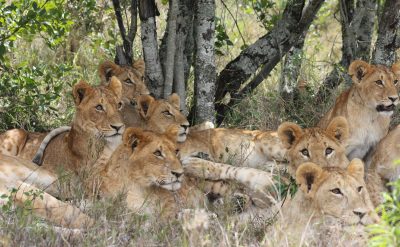University of Wyoming scientists have gained international attention for new research showing that invasive ants in a Kenyan savanna have caused lions to change their predatory behavior. On Friday, Feb. 23, Department of Zoology and Physiology Professor Jacob Goheen and Ph.D. student Douglas Kamaru shared their findings with a vast American audience on National Public Radio’s (NPR) “Science Friday” program.
Their appearance is the culmination of a remarkable month of national and international publicity for UW researchers, with five publications in major scientific journals attracting attention from media outlets across the globe.
The research led by Kamaru and Goheen appeared Jan. 25 in the journal Science, one of the world’s top academic journals. The UW researchers and colleagues from nine other institutions and agencies found that the invasion of big-headed ants at Kenya’s Ol Pejeta Conservancy makes lions less effective at killing zebras, their primary prey. That’s because the invasive insects kill native acacia ants that protect the whistling-thorn tree from elephants and other herbivores, resulting in less tree cover for lions to ambush zebras.

The “Science Friday” interview with Kamaru and Goheen aired on 1 p.m. on Friday, Feb. 23, on NPR and will be available afterward here and here.
“I’m especially happy that this paper was lead-authored by a Kenyan citizen (Kamaru). Africa is a continent with exceptional wildlife diversity, with lots of aspiring young wildlife biologists. Those wildlife biologists often are lacking in opportunity for professional advancement,” says Goheen, who has trained several graduate students from Kenya while conducting wildlife research in both Africa and Wyoming. “We now are at a point where scientific knowledge is rarely the rate-limiting step for conservation of African wildlife. Now, Western scientists working in Africa have an obligation to not just involve locals in their work, but to train local leaders. There are several faculty at UW who are doing this, and they have been doing it for a long time.”
UW’s media release about the research stimulated media attention across the globe. Outlets covering the topic included Forbes, The Washington Post, The Economist, The Atlantic, LeMonde, The Independent, USA Today, The East African, Scientific American, and Barron’s.
But research on African wildlife isn’t the only work by UW scientists gaining international attention. Faculty members in UW’s Department of Anthropology have been in the headlines for research into ancient peoples in the South American Andes and in what is now east-central Wyoming:
• Professor Todd Surovell and his team of collaborators discovered a tube-shaped bead made of bone that is almost 13,000 years old at the La Prele Mammoth site in Converse County. Their findings, published in the journal Scientific Reports, note that the hare-bone bead is the oldest known bead in the Americas.
The La Prele Mammoth site preserves the remains of a killed or scavenged sub-adult Columbian mammoth and an associated camp occupied during the time the animal was butchered.
UW’s media release stimulated coverage from outlets including MSN, Newsweek, The Sacramento Bee, McClatchy News, Live Science, Heritage Daily, WyoFile, Poland’s Onet, and Turkey’s Turkiye.
• Assistant Professor Randy Haas and colleagues from six other institutions published a paper in the journal PLOS ONE showing that early human diets in the Peruvian Andes were composed of 80 percent plant matter and 20 percent meat. That contradicts conventional wisdom that early human economies focused on hunting.
Haas and his colleagues reached their conclusion by analyzing the isotopic composition of bones dating from 9,000 to 6,500 years ago at the Wilamaya Patjxa and Soro Mik’aya Patjxa burial sites in Peru.
UW’s media release helped attract coverage from outlets including The Guardian, Science Magazine, the Argentina Star, Business Insider, The Independent, The Evening Standard, and the Inverness Courier.
• Associate Professor Jason Toohey and Professor Melissa Murphy discovered one of the earliest circular plazas in Andean South America demonstrating monumental megalithic architecture, which refers to construction that uses large stones placed upright with no mortar.
Published in the journal Science Advances, their research at the Callacpuma archaeological site in northern Peru used radiocarbon dating to place the plaza’s initial construction at around 4,750 years ago—about 100 years before the Great Pyramids of Egypt and around the same time as Stonehenge.
UW’s media release so far has stimulated coverage by outlets including the Miami Herald, MSN, The Sacramento Bee, The Archaeologist, and Germany’s Schwarzwaelder Bote.
Another high-profile journal, Proceedings of the National Academy of Sciences, recently published the work of UW Department of Zoology and Physiology postdoctoral research associate Jordan Glass. He found that honey bees carrying nectar have the remarkable ability to adjust their flight behavior to avoid overheating when air temperatures increase to as high as 104 degrees Fahrenheit.
UW’s media release, as well as publicity by Glass’ doctoral institution, Arizona State University, so far has stimulated coverage by outlets including Earth.com, ScienceDaily, and MSN.
“UW’s outstanding researchers are published regularly in major scientific journals, but the past month has brought the most sustained and widest stretch of international exposure over a short period that I can recall in my dozen years at UW,” says Chad Baldwin, associate vice president for marketing and communications. “Our team loves to tell the state and the world about the incredible research being done at UW—much of which includes UW students at even the undergraduate level. We know there will be many more of these stories to tell.”
This story was originally published on UW News.



